Hanfu is the clothing of the ancient Han Chinese before the 17th century, and it is also the oldest Chinese traditional clothes which can be traced back to over 3,000 years ago. The word Han represents the predominant ethnic group in China.
It is said that Hanfu was invented by Huangdi (also called Yellow Emperor), a legendary Chinese sovereign and culture hero of ancient China, and Hanfu was constantly improved history. Different times features and fashion led to cultural differences between all those types of clothing, but the majority of Hanfu followed the pattern of wearing a robe or a shirt as a top garment and a skirt as the bottom. Hanfu also posed a far-reaching influence on the clothing systems in neighboring Asian countries, including Korea and Japan.
As Manchu people took over China from Han people and established the Qing Dynasty, the last imperial dynasty of China, Hanfu gradually retreated from the stage of history. Manchu clothing was introduced and then dominated the country from the 17th century to the 20th century. The 19th-century Opium Wars brought European influences, including western fashion, into China, so Hanfu became more or less obsolete. Continuous wars and social movements in modern China made the situation even worse and almost interrupted the inheritance of the traditional Han clothing.
With the rising of national power and national consciousness, more and more young Chinese consumers favor items that are unique, artisanal, and linked to a rich historical legacy – all of those factors promote a revival of Hanfu. The clothing system which was adopted and vigorously promoted by the ruling class in feudal dynasties now can be attained by every person. They can wear traditional clothing as we wish, walking through the time tunnel of history and seeking ancestors’ traces.
However, Hanfu is still just a niche market far from achieving amassed broad and everyday appeal. Even many Chinese would mistake Hanfu for kimono (traditional Japanese garment) or hanbok (traditional Korean dress). Western-style clothing (which represents conventional fashion) is still given top priority rather than traditional clothing.
The Renaissance of Hanfu still has a long way to go, but it should never be regarded as a heavy burden. Personally speaking, I never regard “make more people know about Hanfu” as a mission, but a personal interest. Hanfu is beautiful. I like it. That’s all. Millennial’s interest in Hanfu is no different than a personal preference for a style of fashion, which should never be over-interpreted as political or nationalistic motives.
Now, let’s open the scroll of history and explore the beauty of female Hanfu in different dynasties.
汉 Han Dynasty 202 B.C.- 220 A.D.


This garment of Han dynasty is a piece of women’s Quju Shenyi (曲裾深衣, Quju dress) made of silk. Ju (裾 [jū]) is the full front and back of a Chinese jacket or gown, and Shenyi (深衣 [shēn yī]) means the deep robe which is a combination of tunic and skirt. It is a full-length dress with standing collar, wrap closure, and loose fit sleeves. The embroidery pattern of this dress symbolized longevity. This type of Qujuqun is usually seen in the archaeological findings of the Han Dynasty, which often occurred in important or formal occasions.

The Han dynasty was the second imperial dynasty of China. During this time, due to the prosperity of economy and the stability of the regime, people’s lives were more settled, and exquisite woven silk fabrics were used more on clothing. The various embroidery patterns such as auspicious cloud reflected the popularity and dominant position of Confucianism.
晋 Jin Dynasty 266 A.D. – 420 A.D.

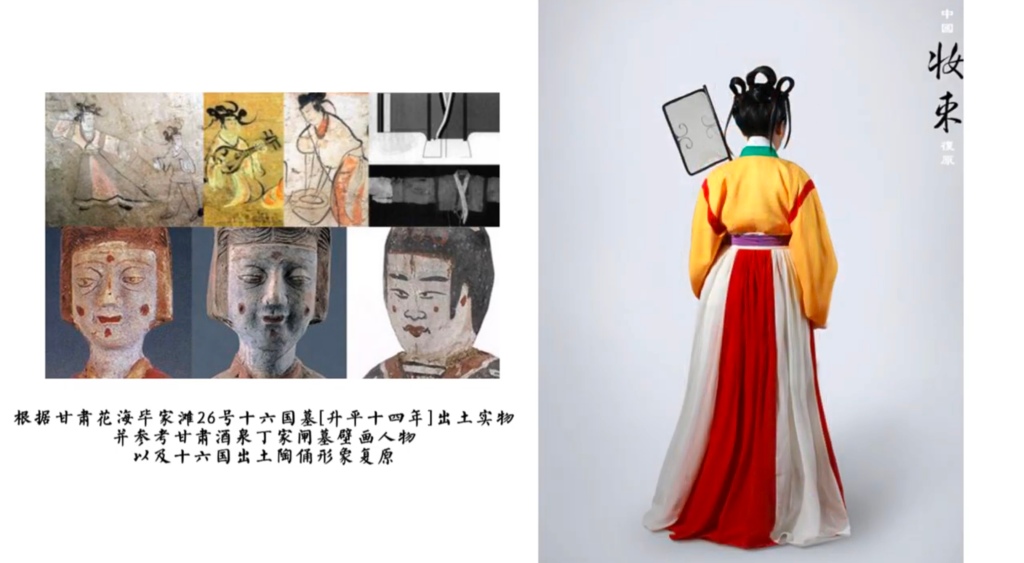
This garment of the Jin dynasty is a piece of women’s Ruqun (襦裙, Qu skirt). Ru (襦[Rú]) means the open cross-collar shirt. The top is a shirt with a y-shaped collar and wide sleeves with colorful closures. The bottom is a maxi skirt with red and white colors.
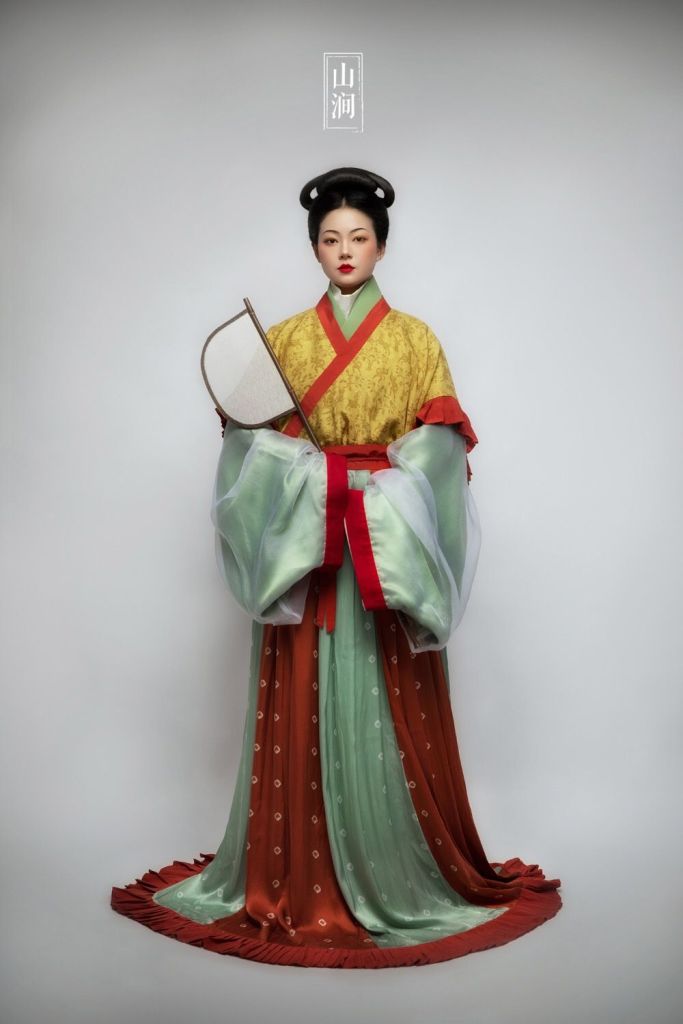
Jin is also called “Weijin”. The demeanor of Jin is a unique phenomenon in the history of Chinese culture. During troubled times when there was no united regime, the rebels and invaders began to establish new self-proclaimed states along the Yellow River valley, inaugurating the “Sixteen Kingdoms” era. Besides, Buddhism has made rapid progress during the wars, the practice of cave cutting and statue carving became popular gradually, so the historical clothing of the Jin dynasty was heavily influenced by the religion and neighboring nomads.
唐五代 Tang Dynasty – Five Dynasties 618 A.D. – 960 A.D.
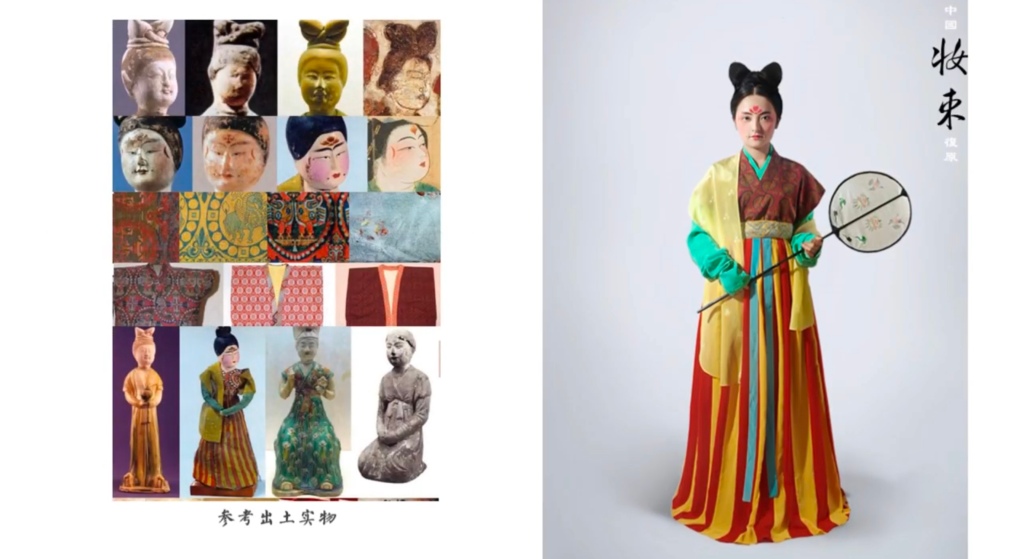
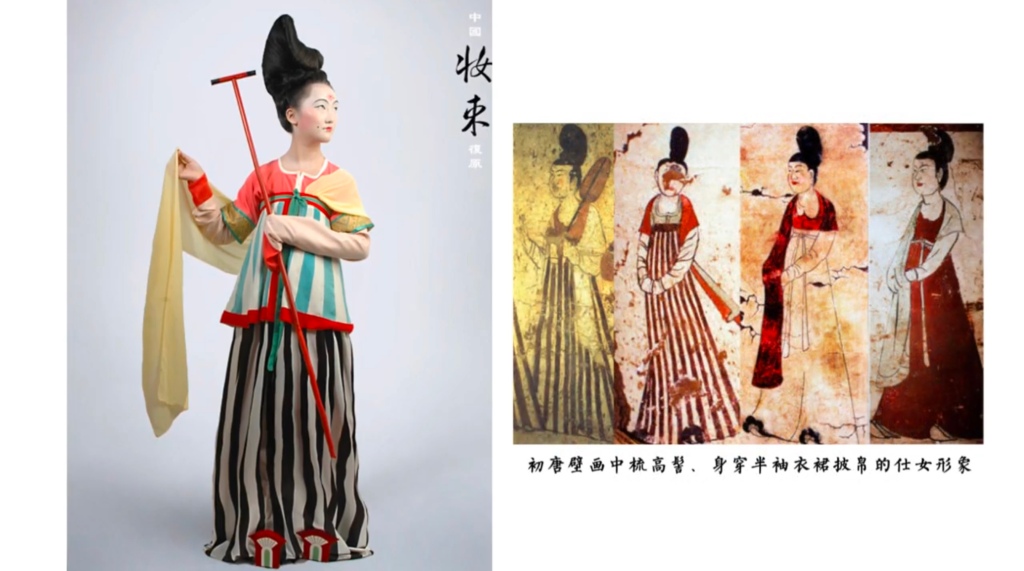
(Source: 装束复原Chinese Historical Costume)
These garments of Tang dynasty are called Banbi (半臂, half sleeves) and Shanqun (衫裙, shirt and skirt). There were some differences between the early period and late period. After the Middle Tang, both skirt and sleeves were much wider, and color schemes were brighter and bolder. During the heyday of the Tang dynasty, China’s power, culture, economy, and influence were thriving. As a result, women could afford to wear loose-fitting, wide-sleeved garments. Even lower-class women’s robes would have sleeves four to five feet in width.
(Source: 装束复原Chinese Historical Costume)
The Tang was widely regarded as a high point in Chinese civilization, and a golden age of cosmopolitan culture. There are numerous films and TV series that set the Tang as background. Concepts of urban elite women’s social rights and social status were notably liberal-minded during the period. One strong evidence could be that Empress Wu Zetian, the only legitimate Chinese empress regnant (or female emperor) in history, seizing the Tang throne for 15 years.
宋 Song Dynasty 960 A.D. – 1279 A. D.

This garment of Han dynasty is a piece of women’s Shanzi (衫子, long shirt). Shanzi and Beizi (褙子, long coat) have a similar function as a thin jacket, and they both have slim fit tapered sleeves or loose fit sleeves. The differences between Shanzi and Beizi are that Beizi is calf-length or even full-length while Shanzi is shorter; Beizi is formal wear in big events but Shanzi is not. Shanzi or Beizi is usually worn with an underwear called Songmo (宋抹, halter top). Skirts and Songku (宋裤, Song pants) made of silk or cotton are the two common bottoms in the Song Dynasty.
(Source: Mingjing Huafu, Zanhuage, Chixia)
Song clothing is contrary to Tang clothing which used a lot of bright colors. Song people favored plain, quiet, and elegant color schemes. The design and style also tended to be more restrained and conservative.

(Source: 装束复原Chinese Historical Costume)
The Song dynasty ended the chaos which is called Five Dynasties and Ten Kingdoms period from 907 A.D to 979 A.D. The Song government was the first in world history to issue banknotes or true paper money nationally and the first Chinese government to establish a permanent standing navy. This dynasty also witnessed the first known use of gunpowder, as well as the first discernment of true north using a compass. Personally speaking, Song is my favorite dynasty throughout China’s history. The social life of citizens was vibrant. Technology, science, philosophy, literature, mathematics, and engineering flourished over the course. The classical aesthetic is also regarded as the most dignified and elegant by many scholars. The imperial courts of the emperor’s palace were filled with his entourage of court painters, calligraphers, poets, and storytellers.
明 Ming Dynasty 1368 A.D. – 1644 A.D.


These ladies are wearing robes with stand collar made of gauze brocade or brocade with golden threads. You can see the two straight lines intersecting in the middle of both the front and back of the robe, which represents the symmetry of traditional culture. The two lines show the unique sense of integrity, which symbolizes a person should be impartial. The robes have wide or extra wide sleeves which make the lines soft and elegant. Different from Hanfu in other dynasties, a large number of buttons were used in the conspicuous part of a Ming robe.
The development and change of women’s clothing are reflected in the proportion of upper and lower skirts. The length of the top is obviously long, which could be knee-length or even calf-length, and the length of the skirt is a little bit reduced. From a visual aspect, the proportion of the human body is bigger, which makes the lady who wears it look more dignified, formal, rigorous, and generous. Ladies in the Ming dynasty usually wore a side-pleated skirt called Mamianqun (马面裙), which is my favorite Hanfu piece actually.
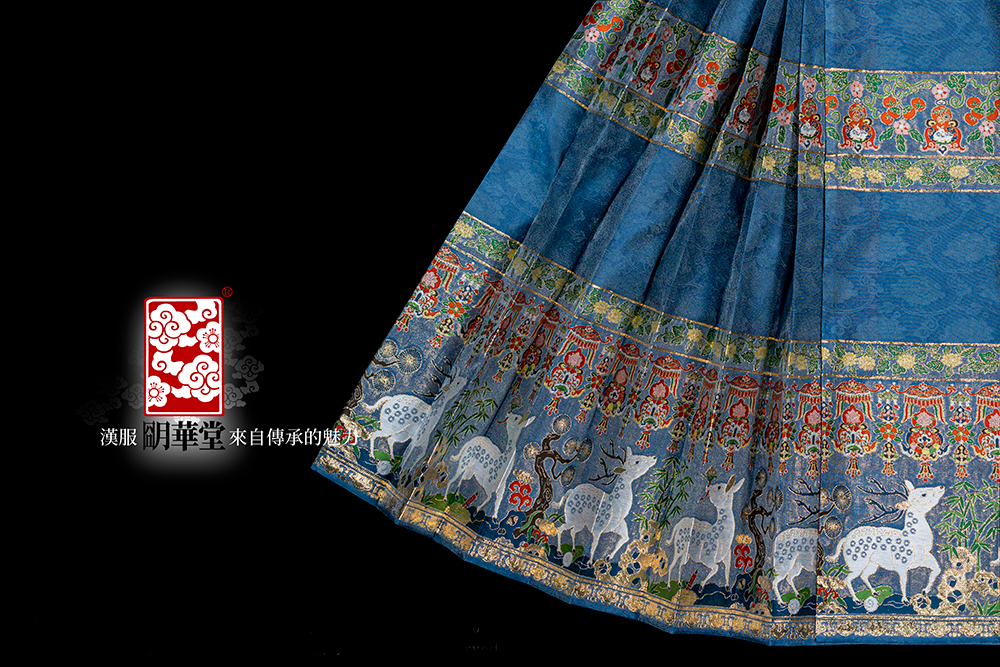
The patterns on the clothing always have auspicious meanings. The most used patterns include dragon, phoenix, flying fish, hulu, cloud, deer, butterflies, and bamboo.
Bijia (比甲, vest) is a different style of Hanfu jacket. It is a kind of sleeveless and collarless vest with two sides open to the knees. It is longer than the later vest, mostly to the hip or knees, some longer. This kind of clothing was originally a kind of Chinese style Hanfu in the Song Dynasty.
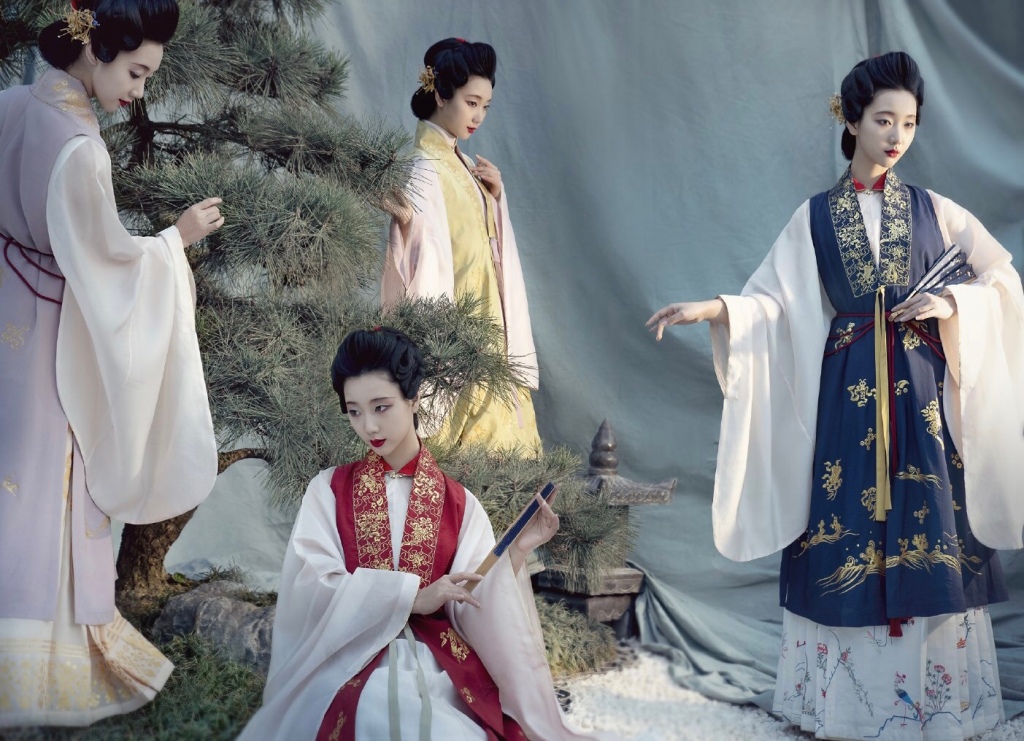
Pifeng (披风, coat) is another popular clothing in the Ming dynasty which can cover more of people’s body. Pifeng has buttoned fronts, straight collar, and extra-wide sleeves. The front part is decorated with a pair of lace for fastening, and the various shaped jade buttons are also used for fastening. It can be worn by both men and women. Pifeng was developed from Beizi (褙子) in the Song and Yuan Dynasty.
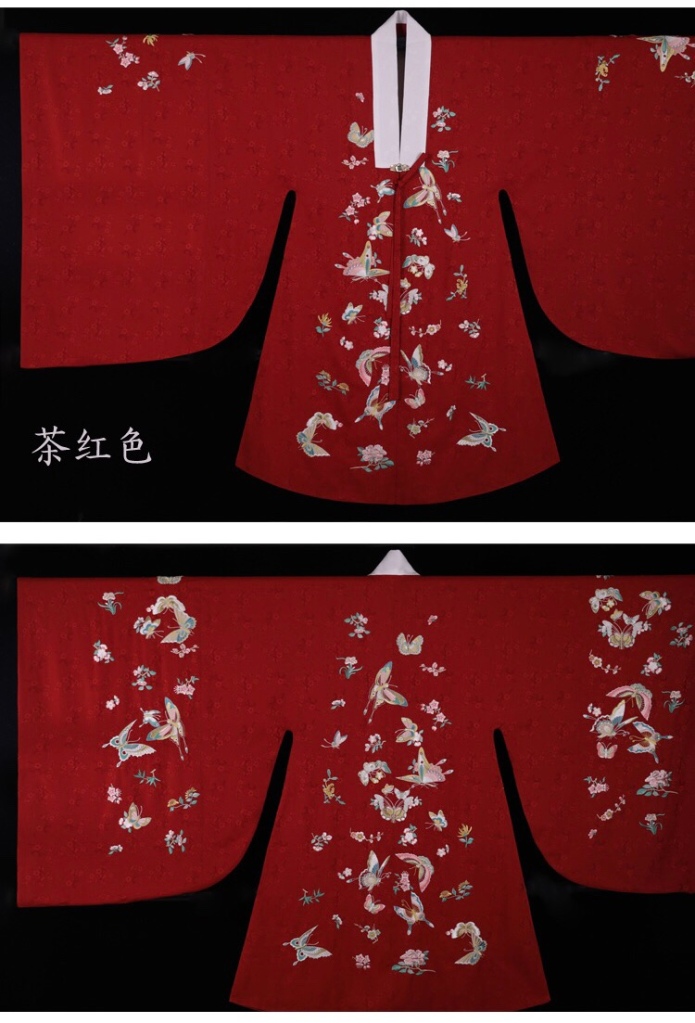
The Ming dynasty was the last imperial dynasty of China ruled by Han Chinese. Literature, painting, poetry, music, and Chinese opera of various types flourished during the Ming dynasty, especially in the economically prosperous lower Yangzi valley. With the development of dyeing technology in the Ming dynasty, dress became more and more gorgeous. Hanfu in Ming Dynasty was said to have the richest styles, the most exquisite production, and the most harmonious color schemes among all the costumes in China.
Overall, most Hanfu has a buttoned front or a collar looks like a lowercase y, and most Hanfu clothing uses ties rather than buttons or zippers. Another feature of Hanfu is that skirts or dresses are all designed to be one piece and uses ties to wear. The common material of Hanfu includes silk, cotton, ramie, and kudzu, and there are a lot of patterns with auspicious meanings on the clothing.
Chinese civilization is also called “Hua Xia”. “Hua” means the beauty of dresses and decorations which is Hanfu, and “Xia” is the grandeur of rites and social conduct. Clearly, Hanfu plays an important role in traditional Chinese culture.
Hanfu clothing for males also has a lot to discuss, which shares some of the same characteristics with female Hanfu. I may talk about male Hanfu in the following posts.
If you are interested, please don’t forget to share this post with other people! Subscribe now!












